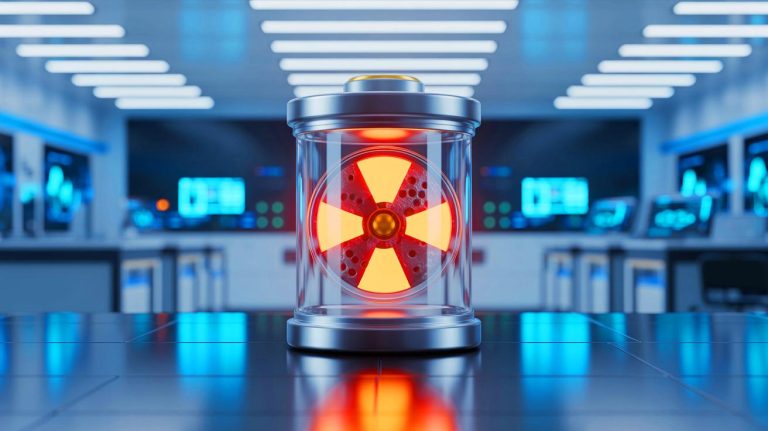| IN A NUTSHELL |
|
In a remarkable leap forward in energy technology, Japan has introduced a new way to utilize nuclear waste. The Japan Atomic Energy Agency (JAEA) has developed a rechargeable battery using depleted uranium, a byproduct of nuclear energy processes. This innovation addresses two significant issues: the storage of nuclear waste and the need for efficient energy storage solutions. As the world grapples with increasing energy demands and environmental concerns, this novel approach could signal a transformative shift in how we manage and utilize resources.
Transforming Nuclear Waste into Energy
The Japan Atomic Energy Agency’s pioneering work with depleted uranium-based batteries represents a significant advancement in energy storage technology. By repurposing a nuclear waste product, JAEA is tackling the dual challenges of waste management and energy efficiency. The uranium-based battery functions similarly to traditional batteries, using electrochemical reactions to store and release energy. However, instead of conventional materials like lithium or lead, these batteries use uranium, offering a novel approach to energy storage.
The prototype battery developed by JAEA is compact, measuring just 4 inches wide and 2 inches tall, yet it delivers a voltage of 1.3 volts, comparable to a standard AA battery. After multiple charge and discharge cycles, the battery demonstrated impressive stability, showing potential as a viable energy storage solution. This development could reshape how we view nuclear waste, transforming it from a liability into a valuable resource.
Addressing Safety and Environmental Concerns
While the potential of uranium-based batteries is significant, safety concerns cannot be overlooked. Japan alone holds 17,637 tons of depleted uranium, contributing to a global total of 1.76 million tons. If harnessed effectively, this vast reserve could become a crucial energy resource. Depleted uranium, though much less radioactive than enriched uranium used in reactors, still requires careful handling and containment to prevent any potential hazards.
Currently, these batteries are confined to controlled environments, such as nuclear facilities, where safety can be closely monitored. Before they can become widespread, extensive testing and rigorous safety protocols must be established. The question of whether these batteries will transition from prototype to market remains open, hinging on the successful navigation of these safety and environmental challenges.
Broader Implications for Renewable Energy
The introduction of uranium-based batteries could have far-reaching implications for the renewable energy sector. By providing a reliable and efficient storage solution, these batteries could facilitate the large-scale adoption of renewable energy sources like solar and wind. The ability to store energy generated during peak production periods and release it when demand is high could significantly enhance the viability of renewable energy projects.
Moreover, these batteries hold promise for use in remote and off-grid locations, where traditional infrastructure may be lacking. The potential to store and deploy energy efficiently using nuclear waste could reduce reliance on fossil fuels, aligning with global efforts to reduce carbon emissions. As research progresses, the potential applications of this technology continue to expand, offering a glimpse into a future where nuclear waste becomes an asset rather than a burden.
Overcoming Challenges and Moving Forward
Despite the promise of uranium-based batteries, several challenges must be addressed to achieve widespread adoption. The risks associated with radioactivity, even with depleted uranium, necessitate stringent safety standards and regulatory oversight. Public perception and acceptance of nuclear technologies also pose significant hurdles that must be overcome through education and transparency.
Additionally, the costs associated with research, development, and regulatory compliance could delay the deployment of this technology. Nonetheless, the potential benefits of transforming nuclear waste into a valuable energy resource are too significant to ignore. Continued innovation and collaboration will be essential in addressing these challenges and advancing this promising technology.
As the world seeks sustainable solutions to energy and environmental challenges, Japan’s innovative use of depleted uranium offers a compelling vision of the future. The potential to turn a problematic waste into a valuable resource represents a significant opportunity. However, the journey from concept to widespread adoption is fraught with challenges. Will uranium-based batteries become a cornerstone of sustainable energy practices, or will they remain a technological curiosity? The answer lies in the balance between innovation and regulation, a challenge that the global community must navigate together.








Wow, this is mind-blowing! 🌟 But how safe is it really?
Hope this doesn’t turn into another nuclear disaster waiting to happen… 😬
Can these batteries be used in everyday household gadgets?
Great innovation, but the safety concerns should not be overlooked!
Are there any plans for mass production of these batteries?
Is the glow-in-the-dark feature a bug or a feature? 😂
Thank you for this groundbreaking research! Hope it paves the way for safer nuclear tech.
How radioactive is this supposed to be? I’m skeptical about the safety!
It sounds like a sci-fi plot. Are we really ready for this?
How long do these batteries last compared to conventional ones?
This could change the world of energy forever. Incredible! ⚡️
Imagine if your phone was powered by nuclear waste… Spooky! 👻
Can depleted uranium really be considered a safe energy source?
I’m not sure I want uranium in my house, battery or not.
Japan is always leading the way with tech innovations. Kudos! 🇯🇵
What would happen if one of these batteries leaked? 😱
Does this mean we’ll have glowing gadgets in the future? 🤩
More details on the safety protocols, please. Seems too risky!
Hope this doesn’t result in “nuclear-powered” conspiracy theories. 😅
I’m all for renewable energy, but this seems a bit extreme.
Big ups to the scientists working on this! 👏
Is there any risk of radiation exposure from using these batteries?
Can we expect to see these batteries in electric cars soon?
I’m all for innovation, but this makes me nervous. 😬
How does this compare in cost to traditional batteries?
What’s the worst that could happen with these batteries? 🤨
Isn’t using nuclear waste as a battery a bit like playing with fire? 🔥
More like a “glow up” for nuclear waste, huh? 😉